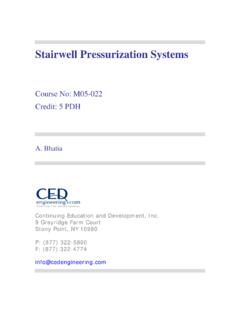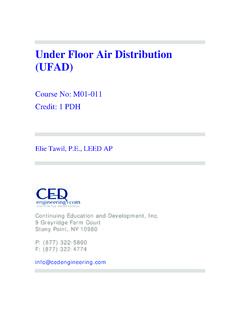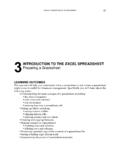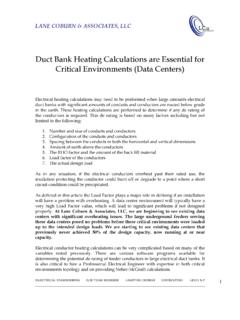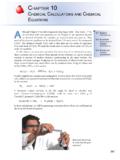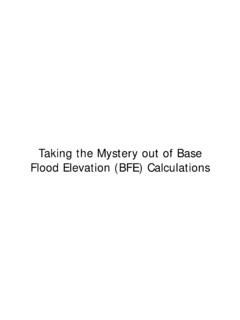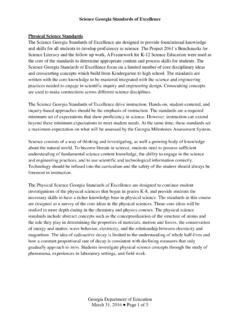Transcription of Cooling Load Calculations and Principles
1 Cooling load Calculations and Principles Course No: M06-004 Credit: 6 PDH A. Bhatia Continuing Education and Development, Inc. 9 Greyridge Farm Court Stony Point, NY 10980 P: (877) 322-5800 F: (877) 322-4774 HVAC Cooling load Calculations AND Principles TABLE OF CONTENTS SIZING your AIR-CONDITIONING HEATING load V/S Cooling load HEAT FLOW SPACE HEAT SPACE HEAT GAIN V/S Cooling load (HEAT STORAGE EFFECT)..7 SPACE Cooling V/S Cooling load (COIL)..8 COMPONENTS OF Cooling Cooling load calculation ACCURACY AND RELIABILITY OF VARIOUS calculation DESIGN OUTDOOR DESIGN WEATHER INDOOR DESIGN CONDITIONS AND THERMAL INDOOR AIR QUALITY AND OUTDOOR AIR BUILDING BUILDING 14 OPERATING Cooling load METHODOLOGY CONSIDERATIONS & THERMAL CLTD/SCL/CLF METHOD OF load calculation (ASHRAE FUNDAMENTALS 1997).
2 16 EXTERNAL Cooling INTERNAL Cooling HEAT GAIN FROM MISCELLANEOUS SUPPLY AIR Cooling load EXAMPLE IN US Cooling load EXAMPLE IN METRIC COMPUTER ELITE TRACE Page 1 of 61 HVAC Cooling load Calculations AND Principles OBJECTIVE Cooling load Calculations may be used to accomplish one or more of the following objectives: a) Provide information for equipment selection, system sizing and system design. b) Provide data for evaluating the optimum possibilities for load reduction. c) Permit analysis of partial loads as required for system design, operation and control.
3 This course provides a procedure for preparing a manual calculation for Cooling load . A number of published methods, tables and charts from industry handbooks, manufacturer s engineering data and manufacturer s catalog data usually provide a good source of design information and criteria in the preparation of the HVAC load calculation . It is not the intent of this course to duplicate this information but rather to extract appropriate data from these documents as well as provide a direction regarding the proper use or application of such data so that engineers and designers involved in preparing the Calculations can make the appropriate decision and/or apply proper engineering judgment.
4 The course includes two example Calculations for better understanding of the subject. TERMINOLOGY Commonly used terms relative to heat transmission and load Calculations are defined below in accordance with ASHRAE Standard 12-75, Refrigeration Terms and Definitions. Space is either a volume or a site without a partition or a partitioned room or group of rooms. Room is an enclosed or partitioned space that is usually treated as single load . Zone is a space or group of spaces within a building with heating and/or Cooling requirements sufficiently similar so that comfort conditions can be maintained throughout by a single controlling device.
5 British thermal unit (Btu) - is the approximate heat required to raise 1 lb. of water 1 deg Fahrenheit, from 590F to 600F. Air conditioners are rated by the number of British Thermal Units (Btu) of heat they can remove per hour. Another common rating term for air conditioning size is the "ton," which is 12,000 Btu per hour and Watts. Some countries utilize one unit, more than the others and therefore it is good if you can remember the relationship between BTU/hr, Ton, and Watts. 1 ton is equivalent to 12,000 BTU/hr. and 12,000 BTU/hr is equivalent to 3,516 Watts - or kW (kilo-Watts).
6 Cooling load Temperature Difference (CLTD) an equivalent temperature difference used for calculating the instantaneous external Cooling load across a wall or roof. Page 2 of 61 HVAC Cooling load Calculations AND Principles Sensible Heat Gain is the energy added to the space by conduction, convection and/or radiation. Latent Heat Gain is the energy added to the space when moisture is added to the space by means of vapor emitted by the occupants, generated by a process or through air infiltration from outside or adjacent areas. Radiant Heat Gain the rate at which heat absorbed is by the surfaces enclosing the space and the objects within the space.
7 Space Heat Gain is the rate at which heat enters into and/or is generated within the conditioned space during a given time interval. Space Cooling load is the rate at which energy must be removed from a space to maintain a constant space air temperature. Space Heat Extraction Rate - the rate at which heat is removed from the conditioned space and is equal to the space Cooling load if the room temperature remains constant. Temperature, Dry Bulb is the temperature of air indicated by a regular thermometer. Temperature, Wet Bulb is the temperature measured by a thermometer that has a bulb wrapped in wet cloth.
8 The evaporation of water from the thermometer has a Cooling effect, so the temperature indicated by the wet bulb thermometer is less than the temperature indicated by a dry-bulb (normal, unmodified) thermometer. The rate of evaporation from the wet-bulb thermometer depends on the humidity of the air. Evaporation is slower when the air is already full of water vapor. For this reason, the difference in the temperatures indicated by ordinary dry bulb and wet bulb thermometers gives a measure of atmospheric humidity. Temperature, Dewpoint is the temperature to which air must be cooled in order to reach saturation or at which the condensation of water vapor in a space begins for a given state of humidity and pressure.
9 Relative humidity - describes how far the air is from saturation. It is a useful term for expressing the amount of water vapor when discussing the amount and rate of evaporation. One way to approach saturation, a relative humidity of 100%, is to cool the air. It is therefore useful to know how much the air needs to be cooled to reach saturation. Thermal Transmittance or Heat Transfer Coefficient (U-factor) is the rate of heat flow through a unit area of building envelope material or assembly, including its boundary films, per unit of temperature difference between the inside and outside air.
10 The U-factor is expressed in Btu/ (hr 0F ft2). Thermal Resistance (R) is the reciprocal of a heat transfer coefficient and is expressed in (hr 0F ft2)/Btu. For example, a wall with a U-value of would have a resistance value of R = 1/U = 1 The value of R is also used to represent Thermal Resistivity, the reciprocal of the thermal conductivity. Page 3 of 61 HVAC Cooling load Calculations AND Principles SIZING your AIR-CONDITIONING SYSTEM Concepts and fundamentals of air conditioner sizing is based on heat gain, and/or losses in a building. It is obvious that you will need to remove the amount of heat gain - if it is hot outside.


